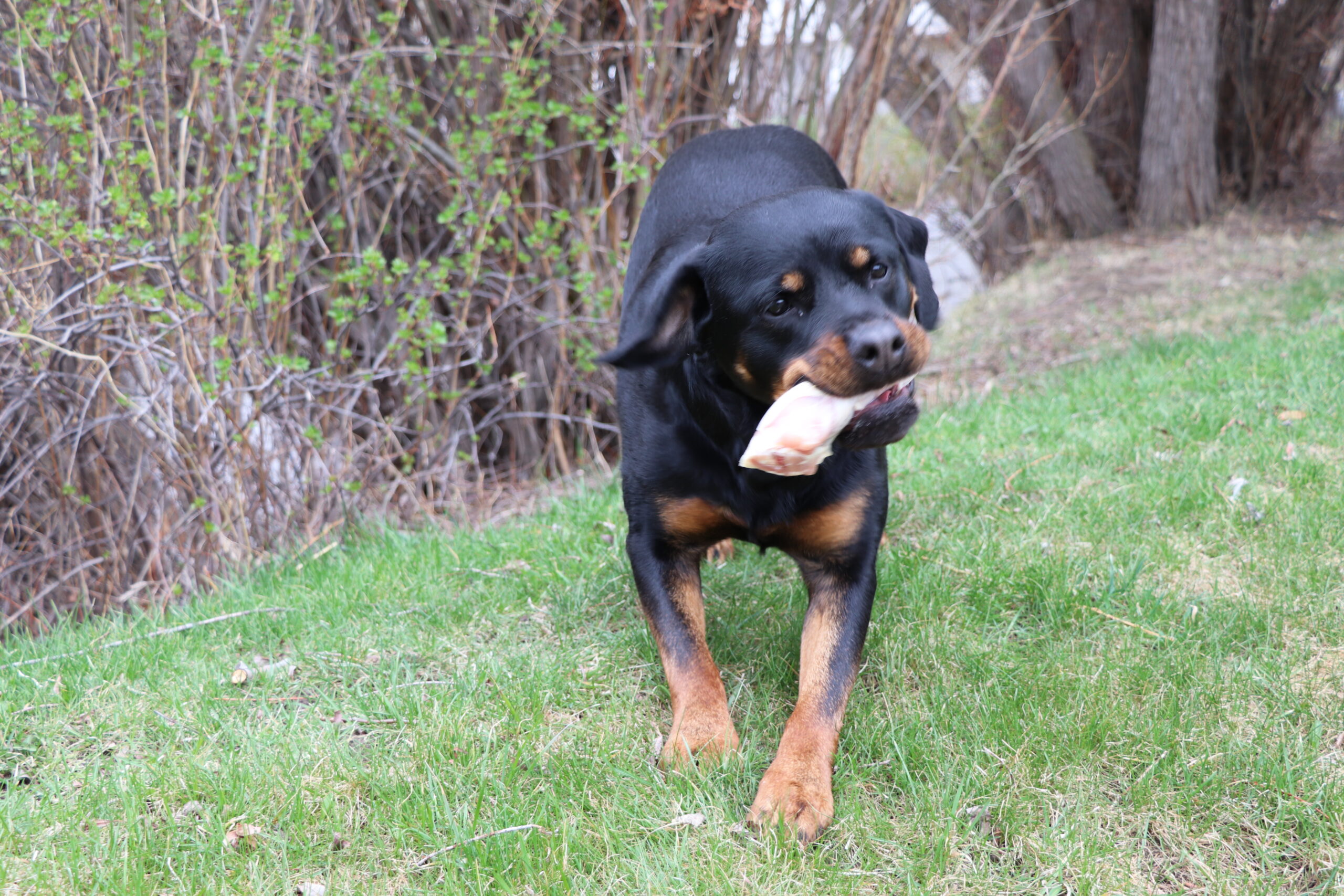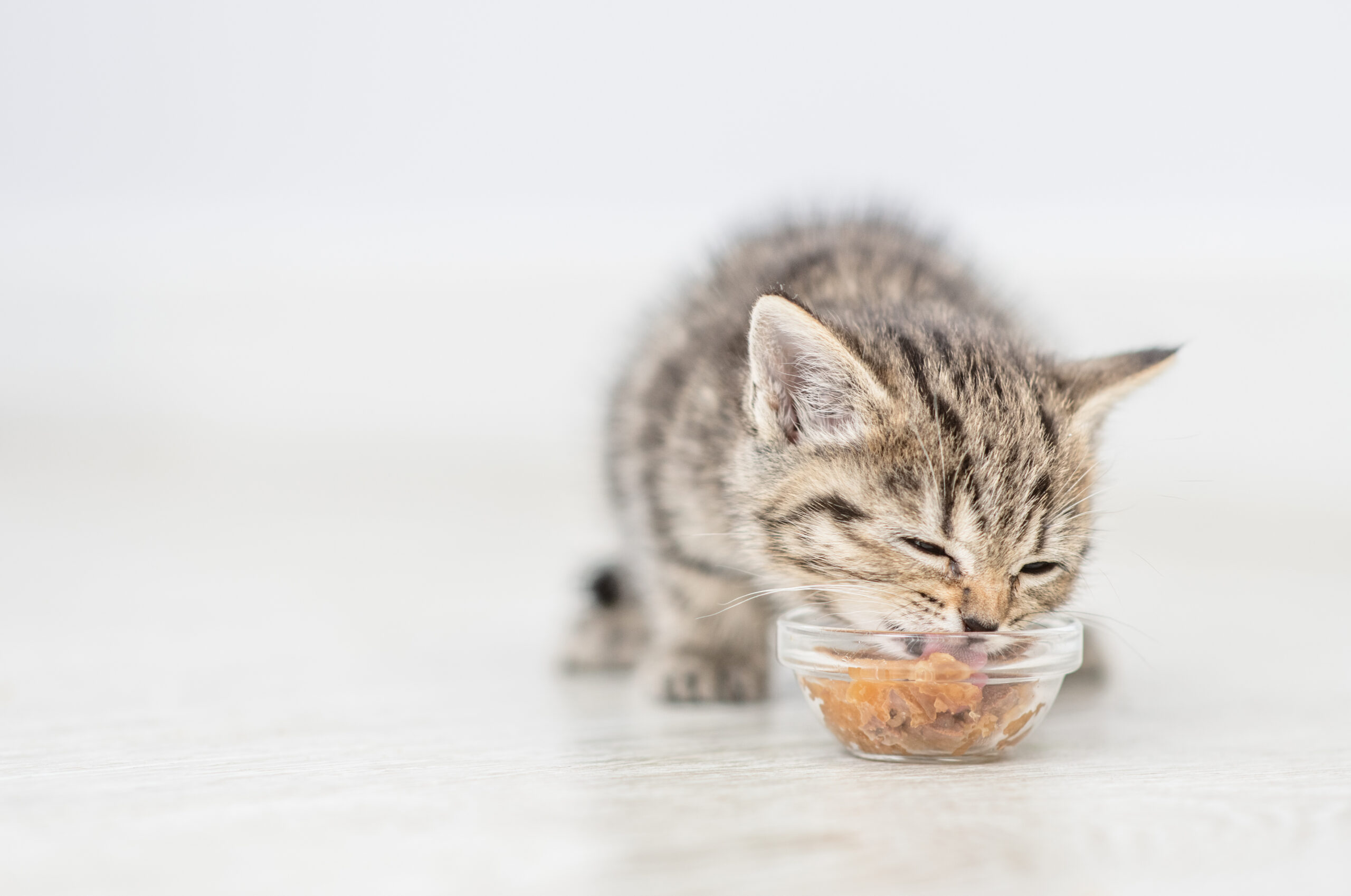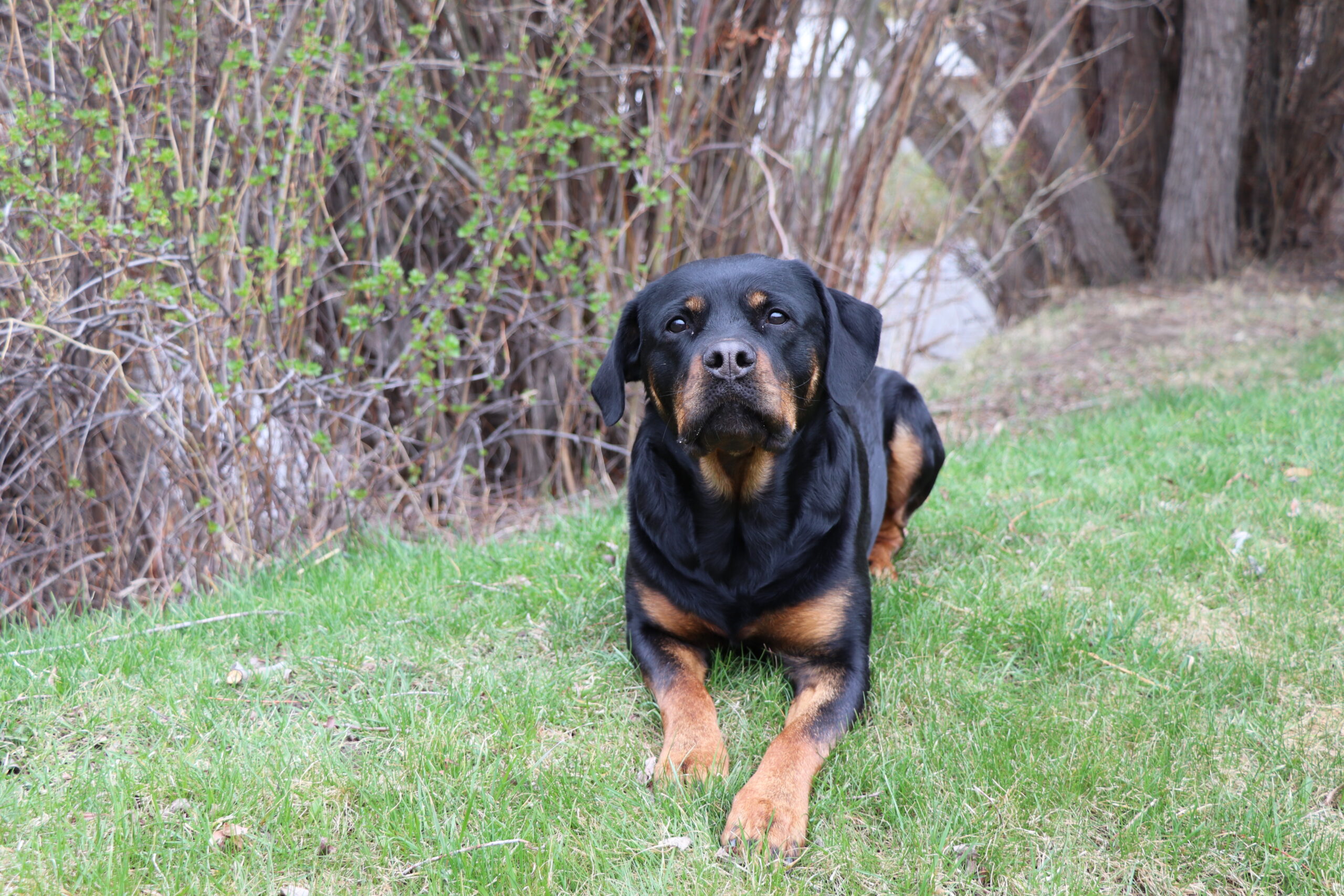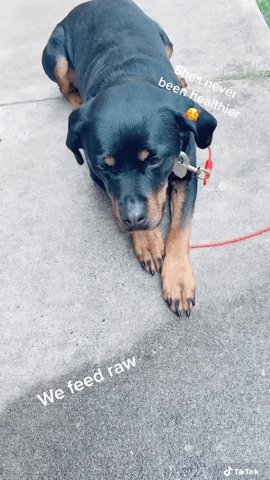
Modern dogs are riddled with the same problems humans in industrialized nations are. Allergies, flakey dry skin, joint pain, cancer. Nutrient deficiencies and allergies caused by well-meaning pet owners, predatory profit-seeking pet food companies, and ignorant veterinary advice are the biggest contributor to chronic illness in dogs.
The appropriate diet for a dog is mostly meat. Meat, including bones and organ meat, in its raw form provides the nutrition dogs need. Some dogs will thrive with eggs as well, and some will not. Most dogs will do the best on bone-in raw meat, as you can see Sasha eating above.
Inferior sources of calories such as grains, pea protein, soybean meal, vegetable oil, or fillers such as fiber and vegetables, are not beneficial to the dog. They do provide calories at a low cost, so a dog that is low weight, and happens to not have allergies to these non-biologically-appropriate plants.
What about evolution?
While dogs have clearly been selectively bred for certain traits, they are absolutely not bred to thrive on plant calories. They thrive on meat. Their stomach acid ph is still really low (this means highly acidic), and their digestive tract is short.
Remember, we can selectively breed to make certain traits more likely (like Rottweiler markings and build!) but repeated exposure to the wrong food, even through many generations, does NOT change the genes.
Just because dogs have been fed poor diets for generations now does not mean that they have evolved to thrive on those diets.
What is a species-appropriate diet for a dog?
Thankfully, dogs are quite simple to feed! Dogs, descended from wolves and coyotes (Science Direct 1993), are scavengers, meaning they naturally scavenge for whatever they can eat. In the wild this could mean carcasses of animals that died of natural causes, fresh meat that they kill, and leftovers from other animal’s kills. Dogs also eat some plants, mostly berries and grass, though greatly prefer meat.
As scavengers, dogs thrive on a ‘feast of famine’ lifestyle, where they are biologically designed to thrive on fewer large meals. In the wild, a dog may eat a large meal, and then go days before another. During the days between the meals, the dog keeps good energy for hunting and fending off predators.
Sample meals (one meal a day) for dogs:
These sample meals are based on a 50-lb dog. Your dog’s nutrient needs may vary based on age and activity level.
**This is informational and opinion in nature and cannot be considered nutrition advice. I am not qualified to advise you on your specific animal’s nutritional requirements. I always recommend running any dietary change, whether it for yourself, your child, or your animal, by a qualified professional, which I am not. **
Remember: You are not adding nutrition to your dog by adding fiber or vegetables. If you use your dog as ‘the garbage disposal’ to clean up otherwise uneaten food- but his diet is still mostly meat- that is just fine and mimics what they get in the wild!
Option 1- Red meat:
We alternate between giving our dog red meat and chicken. She gets chicken for the most part, unless we have some old venison, tough elk, etc. to use up. Red meat is more calorie-dense, which is why we feed less of it. The fish is eaten to add calcium from the bone, if there aren’t sensitivities, bone-in chicken can also be used.
- 1 pound a day raw beef or other red meat, daily.
- Once a week or more often: 4 ounces bone-in fish.
- Once a week or two: 4 ounces liver and/or other organ meat
- Once a week: 8-ounce marrow bone (dog will chew on it).
Option 2- Chicken:
Some dogs will show sensitivities to chicken. In general, though, chicken is a good mix of being inexpensive, containing the bones that dogs need, and having fats from the skin and collagen from the ligaments and tendons. The bones are good for the dogs, always get your dog bone-in chicken.
- 1.25 lbs raw bone-in, skin-on chicken (we get drumsticks, wings, or thighs) daily
- Once a week or two: 4 ounces organ meats in addition to the chicken
Option 3- the scrappy option for dogs with easy-going digestion:
This is a nice balance between giving your dog table scraps in a healthy way and also giving the dog raw meat. Table scraps mimic the dog’s natural ‘scavenger’ biology in that they would eat what was available in the wild. That might be some plants, but still would be mostly meat and eggs.
Some dogs do better than others on scraps, see the notes below.
- 1 pound RAW bone-in chicken, daily
- Approx. 200 calories in table scraps a day (ie, cold scrambled eggs, the little bit of taco meat the toddler didn’t eat, some salad or cooked vegetables if your dog eats it)
- Once a week or two: 4 ounces organ meats, or less if included in the table scraps.
When feeding your dog table scraps:
- Never ever give your dog cooked chicken bones! Cooked chicken bones splinter in a dog’s digestive system. Even cooked beef or pork bones are not good for many dogs; they will break off chips that will irritate their digestive tract. When feeding bone, raw is best.
- Always avoid the following foods, which can be toxic to dogs:
- Almonds
- Chocolate & Cocoa
- Onions
- Garlic
- Avocado
- Xylitol
- Grapes and raisins.
- Watch his digestion! Some dogs will tolerate table scraps better than others. Sasha (pictured) really only gets meat table scraps. She doesn’t do well with seasonings, dairy, or grains. And I’ve learned that having her clean off a plate for me is NOT worth having to get up twice that night to let her out to potty!
What’s in commercial pet food?
“Vitamins and minerals” if you ask our vet tech… Ugh. Vitamins and minerals are added to commercial pet food to try to re-create the nutrition found in meat at a less expensive price. But commercial pet food is woefully inadequate, that’s why they have to add supplements to it.
In recent years there has been a lot of education about the negative effects of grains on human digestion, and also dog digestion. For that reason, higher quality pet-food brands advertise that their food is ‘grain free’. That is a great start!
But unfortunately, in place of grains commonly pea protein and/or potato is used as a filler. This filler has been linked with cardiomyopathy and the death of hundreds of dogs.
Dilated cardiomyopathy (DCM) itself is not considered rare in dogs, but these reports are unusual because many of the reported cases occurred in breeds of dogs not typically genetically prone to the disease. Additionally, most of the cases ate diets that appear to contain high concentrations/ratios of certain ingredients, such as peas, chickpeas, lentils and/or various types of potatoes. (FDA 2019)
Other ingredients commonly found in commercial dog food:
- Wheat
- Rice
- Corn
- Vegetable oil
- Soybean
- Beet puree
- Potassium chloride
- Folic acid
- L-Lysine Monohydrochloride (amino acid supplement)
- DL-Methionine (amino acid supplement)
- Vitamin D supplement
- Vitamin A supplement
- Vitamin E supplement
- Vitamin B1, B2, B 6, B12 supplements
All of the vitamins and minerals supplemented are present naturally in meat, organs, and bones.
Why does my vet recommend commercial pet food?
Your vet recommends commercial pet food for a few reasons, none of which are ill intentioned. First, because they know that your dog won’t have any gross deficiencies if it eats commercially prepared food. Your vet knows that by following the recommendations on the bag of pet food for your pet, your dog will be okay. Maybe not great- but okay.
This isn’t much different than a doctor recommending you follow the food pyramid guidelines for yourself or your child. It might not be the best diet for you, but based on your doctor’s knowledge, it’s probably somewhat okay for most people.
Your vet may have seen dogs in their practice present severely malnourished due to uneducated homemade food, and wants to avoid this outcome. They might not understand raw feeding, or have looked into it, and they choose to say ‘no’ to the unknown.
The second reason your vet may recommend commercial pet food is that veterinary school, including the nutrition class, is sponsored by commercial pet food companies (American Veterinarian Medical Association). How do you think it would look to these sponsors if the pet nutrition class covered the actual benefits of a well-formulated raw food diet and it out preformed the commercial pet food health-wise? Do you think they would continue to support the AVMA if their stance was that ‘raw food is superior to commercial dog food for a dog’s long-term health’?

What about salmonella and e coli?
Your dog’s stomach acid is highly acidic. It is about a pH of 2 when fasted, and lowers to 1 when your dog is fed (J Pharm Science 2009). This acidity kills both ecoli and salmonella, which can only survive to a pH of 1.5 (e coli) and 3.5 (salmonella). Remember, in the wild dogs prefer fresh meat, but they absolutely will eat a decomposing carcass that they find as they are scavenging for food.
Dogs are scavengers, much like vultures. Their digestive system is designed for this- other animals that are not scavengers do not eat decomposing meat. And I don’t know about you, but left to her own devices, my dog will find all sorts of ‘litter box treats’ that are probably crawling with all sorts of bacteria, and other than passing some gross gas, she is no worse for it.
The only time you need to be concerned about salmonella and e coli is when you are feeding raw in the house, and storing the meat in your fridge. After feeding your dog, you will want to wash your hands, just like you would after handling raw meat. Proper food storage and handling techniques should be used.
I’m still not comfortable with raw, how about I cook the meat first?
Cooking meat does change the protein structure, and may change the vitamin and mineral content of the meat. You don’t want to give dog’s cooked bones, so bones would be out. If you are set on cooking the food, you will want to look into what needs to be added to the meat to replace the bone not eaten, and replace the vitamins and minerals and proteins that are changed during cooking.
What are potential problems to look for when feeding raw?
Resource Guarding and Dominance Issues: As we started feeding Sasha raw food, she did become more territorial with her food. She seemed to be more instinctual, and we had to ‘challenge her’ often to keep her from growling/defending her food. Her breed is susceptible to ‘wanting to be in control’ and we saw this pick up a bit as we changed her diet.
My best guess for this is that she feels better on a raw food diet. Some of her obedience may have been because she mildly didn’t feel good. I don’t know about you, but if I’m slightly under the weather, I’m much less likely to be assertive.
You can see in the video below that she is required to eat when she says we can eat- she is not allowed to snatch the food from our hand, etc. This helps her know her place in the family, as one who does as she is told rather than one who calls the shots.
Your dog will no longer be lethargic. This means their energy and focus will probably go up. If you have a dog that is already bored (and possibly destructive), or needs a lot of exercise this may not be a welcome change. Where we like to have the high energy levels and mental acuity when we’re eating the correct diet, the change in our pets is something to be aware of!
The raw diet is more expensive for larger dogs. Dog food is cheap! The fillers are a source of calories at a low price point. Where we’re saving about $50/month on cat food by switching to raw, we’re spending about $2/day to feed our 75-pound dog all meat.
Also, this meat isn’t all sustainably raised (but neither is the meat in dog food) so ethically there is the concern of supporting factory farming.
A combination of raw food and dry food works well for many people too, to get many of the increased nutritional benefits of raw with some of the inexpensive calories from kibble.
Cost is a consideration though, and I would never want someone to think I was judging that they fed their dog a diet they could afford. When money is tight, if I have to pick between my kids having good nutrition and my dog having good nutrition, I always will choose to feed my kids well and the dog can have dog food.
How do I transition my dog to raw food?
Dogs who eat commercial dog food, even wet food or high-quality, have probably adapted to that food. To digest meat, a dog’s stomach acid needs to be a low pH. Naturally, dogs will have a very low pH, but you are transitioning to raw after a lifetime of grain-based food your dog’s stomach might not be ready for all meat yet.
You know your dog- dogs with easily upset stomachs benefit from a slow transition to any food change. You can start by feeding 1 chicken wing a day in addition to 3/4 of the dog’s regular dog food, and gradually go up in meat and down in dog food until you are feeding your dog all meat.
On the other hand, if your dog is a ‘garbage disposal’ type, and fine no matter what you feed them, you can probably switch right to meat and be just fine.
Always remember to consult a qualified animal nutrition professional before changing your dog’s diet. The above is informational in nature, and opinion of the author only.

What about homemade food for cats?
Cats are more complicated to feed than dogs are. Cats are obligate carnivores, while dogs are scavengers and can thrive on a less strict diet. Following a recipe for cat food is recommended.
If you don’t follow a recipe, and instead just give your cats raw meat, you absolutely must supplement with taurine. (add about 200 mg per day, or 50 mg per ounce of food- more is better than not enough) Thousands of cats have died from lack of taurine in both commercial pet food and homemade pet food.
When making homemade food for cats you also want to avoid too much liver, or cod liver oil, as vitamin A toxicity is also much more common with cats than dogs.
Feed your cat nose-to-tail animals that are smaller than they are (what they could realistically catch in the wild). This includes bones, muscles, and organs – especially the heart, which naturally has taurine in it. If you can find small animals (ie chickens rather than beef) that is a more natural diet for a cat!
Here are the cat food recipes we use.
Learn how to heal leaky gut

60-page ebook of all my best GAPS Diet (Gut and Psychology Syndrome) articles all in one place.




I love the idea of feeding raw meat and especially with the bones in it. However, my one worry is my dog eating the raw meat and then licking me or my children. Can we get sick from that?
I think there is something about the saliva in the dog’s mouth that makes this not really an issue- however, I don’t let my dogs lick my kids (since they also lick their butt and it grosses me out!) but I have had a couple people ask similar questions so I’ll see if I can find out more about this.
Cara, great article! We recently switched our aging dog to plain raw ground beef as she didn’t have an appetite for any commercial (or fresh) food. We brought her back from the dead, literally, and now her skin and coat/flesh are smooth and filled out. She’s really thriving on it! Have yet to try raw chicken.
One note re the “doggie don’ts” food list; while raw garlic does have higher concentrations of allicin (only problematic in a dose-dependent fashion) than dehydrated garlic, it is actually fine for dogs year round, lifelong – given at the proper amount! It has been used for millennia as human/animal insect repellent and is used today by veterinarians as a natural pest control method. Garlic unfortunately got a bad reputation years ago due to one study with faulty conclusions. We use Summertime garlic granules (and have done so for years) to ward off pests naturally in both our livestock and dogs and it is a much safer alternative to synthetic pesticides.
This great! Thank you for sharing.
Thank you! We are getting a dog this summer and this is so helpful!
Hi Cara,
So glad I stumbled across this article. I am wanting to feed our dog raw as well. Was curious where you buy the raw meet you feed your pup. Any tips on where to buy, which cuts or parts are best? Hoping to feed raw without breaking the bank. Also is a chest freezer a necessity to feed a large dog a raw diet?
Hi! I just buy chicken from the grocery store; wings, thighs, and drumsticks. I just buy enough for the week for her (7ish lbs) during my normal weekly grocery shopping so no need for a chest freezer! Overall it’s really easy!
Dogs were wolves before being domesticated, so they would eat raw meat.
Thank you for this article. I’m interested in transitioning my cat. Could you please get in touch with me as I have questions about a product that I purchased and can’t access?